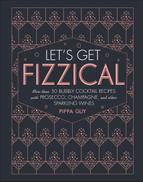COCKTAIL BASICS
OVER THE NEXT few pages, you’ll delve into the details and learn everything you need to know to become a cocktail pro. If you’re eager to dive straight into the recipes, why not consult this handy guide to get a handle on the basics first?
How MANY DRINKS does each RECIPE MAKE?
Each recipe in this book makes one drink. This is traditional for cocktail recipes, as people tend to order different drinks, so bartenders are usually making one drink at a time. It also makes the math easy if you need to increase quantities.
HOW FULL should my GLASS BE?
The general rule is to leave a two-finger gap for drinks served in a Champagne flute and a one-finger gap in other glasses. Avoid filling to the brim, as your drink will spill!
DO I NEED a GARNISH?
Garnishes work best when they are relevant to the ingredients of the drink. However, you don’t need to stick to the ones listed in the recipes—you can get as creative as you like or get rid of them altogether.

THE TECHNIQUES
Making a cocktail isn’t as simple as just throwing all the ingredients together. Depending on the ingredients, there are a number of different preparation techniques:
• BUILD Each ingredient should be added directly to the serving glass.
• SHAKE Some or all of the ingredients are vigorously shaken in a cocktail shaker.
• STIR Some or all of the ingredients are stirred in a mixing glass with ice.
• MUDDLE Ingredient(s) should be mashed up into a pulp.
• LIGHTLY MUDDLE Ingredient(s) should be gently bruised to release flavors.
• STRAIN Stirred and shaken cocktails are always strained to ensure unwanted ice or ingredients don’t go into the serving glass.
• DOUBLE STRAIN A fine strainer should be used with your normal strainer to catch any extra shards of ice or any tiny pieces of unwanted ingredients.
THE INGREDIENTS
Aside from the bubbly, fruit juice, and spirits, there are a few more complex ingredients that may pop up in the recipes. These add flavor and help to balance the drink:
• BITTERS Intense and highly concentrated, bitters are alcoholic spirits with botanical flavorings. Used sparingly in cocktails to add complexity—a bit like salt and pepper in cooking!
• SYRUP A sweetening agent made from sugar, water, and often additional flavors, such as citrus.
• PURéE A thick liquid made from blended fruit, often with added sugar.
• CORDIAL A fruit- or citrus-based syrup.
• INFUSION A base liquid that has been rested with an ingredient to allow it to adopt the flavor.
• LIQUEUR A low-alcohol distilled spirit that has been infused with a flavor and sweetened.
THE GARNISHES
A garnish shows off the flavour profile of a drink and adds a creative finish.
• TWIST A piece of citrus peel, lightly twisted to release oils and aromas. Make sure you remove the bitter pith. Placed decoratively on or in the drink.

• SPRIG A small top stem section of a herb with leaves or flowers. This part is the freshest and most aesthetically pleasing for garnishes.
• ZEST Grated peel from a citrus fruit. It adds flavour as well as a burst of colour.
• RIM Adding salt or sugar to the edge of the glass to add flavour and decoration. This also works well with edible glitter.
• COIN Essentially the same as a twist but smaller, circular and subtler.

• WEDGE A slice of fruit. It adds flavour and bold colour.
• COCKTAIL STICK A small, thin stick for skewering garnishes and displaying them in or across the glass.
